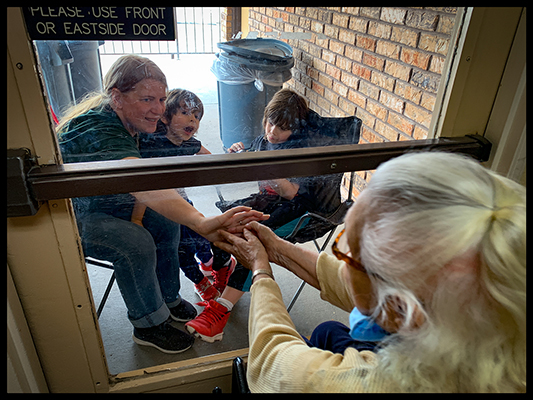Read more about Theoretical Perspectives

Towards a Contemporary Theorization of Work
by G. Günter Voss
November 05, 2021
Social responses to the COVID-19 pandemic extend from the micro level of interpersonal interactions in domestic and virtual settings, to the macro level in which care practices and relations, writ large, affect entire national populations and their transnational exchanges. Actions at each of these levels need to be understood as forms of care.
Developing theoretical understandings that acknowledge the importance of care has become increasingly important for social theory and sociological research in recent years. Evidence from the COVID-19 pandemic in 2020-21 shows a distressing response by national governments and international institutions. While the public health response in a few countries demonstrated that it was possible to limit the impact of the pandemic, most countries struggled.
Under the stress of the pandemic, the state assumed caring responsibilities for the entire nation, taking on the task of supporting and protecting the population and managing their well-being with varying degrees of success. With markets unable to respond and in danger of collapsing entirely, the response by political leaders, improvised at the time and only partially successful in managing the subsequent events, was structured by the constitutional powers, institutions, and conventions which constitute state machinery.
Over the past two and a half centuries, in the era of social transformation from feudalism and tradition to global capitalism that produced the modern world, increasingly complex sets of social institutions for care provision emerged in what Polanyi termed “market societies.” In the most recent phase, the restructuring of contemporary welfare capitalism has seen the state in most advanced economies using its powers to increasingly transform care through the promotion of service markets. The operation of these markets and quasi-markets in various forms, from childcare and education, through disability support and medical care across the life course, to aged care and housing, have come to increasingly underpin and shape modern life.
One of the most important challenges to social theory revealed in this process is the relatively ineffective response evident from most of the advanced capitalist economies, particularly those of Western Europe and North America. These wealthy, developed countries that normally head the global lists of affluent populations who enjoy high living standards, countries with supposedly effective regulatory systems and well-performing health and welfare systems, were found to be particularly vulnerable.
In 2020, caught out first by the spread of the virus, then later by problems with access to medical treatment, governments of most advanced capitalist economies were unable to bring the contagion under effective control. In 2021, problems with vaccination supply and coverage, accompanied by widespread hostility towards and suspicion of vaccinations fanned by a range of ultra-conservative conspiracy movements and naïve believers in wellness and natural health, seemed to echo and then repeat the initial muddling steps of most of the wealthy capitalist welfare states.
The problems of social regulation and administration exposed by the pandemic were expressed in a myriad of forms, perhaps none more poignant and tragic than the unnecessary deaths of hundreds of thousands of the residents of aged care homes across the OECD. Care homes, in this sense, serve as a case study, a microcosm in which it is possible to identify and delineate many of the wide range of problems that the pandemic has exposed in the broader systems of care provision and regulation at the local, national, and global level.
Building on care theory, two propositions drawn from Polanyi’s analysis of the creation of market society are advanced here with the intention of contributing to the theoretical understanding of the political and economic dimensions of care and informing international research on the response to the pandemic. The first identifies problems of governance arising from the marketization of care; the second concerns the consequences of the commodification of public care, particularly as expressed in the reliance on the increasingly precarious labor of care workers and other frontline staff.
Deaths in care homes
During the first wave of Covid in 2020, mortality data was often unreliable and understated. Deaths in care homes were initially omitted from national totals in some countries. Recent data published by the International Long-Term Care Policy Network in February 2021 show that in 22 countries for which reliable figures were available over the first year of the pandemic, on average 41% of all COVID-19 deaths were among care home residents. This ranged from 75% of all Covid deaths in Australia to just 8% reported in South Korea. The figures are disproportionately high in most countries for which data is available. In Canada, 59% of all Covid deaths were in care homes, in the Netherlands 51%, Sweden 47%, Austria 44%. In the USA, there were 139,699 deaths in aged care homes, 39% of the national total of deaths in the first year of the pandemic.
Care homes are funded and regulated by the state to care and protect older people in need of support. They should serve as safe havens from contagion, offering their residents protection. Instead, they became centers for the spread of infection amongst the most vulnerable age group, evidence of the widespread failure of public policies to provide protection. The failure of the care homes in comparison with home-based care to protect against the spread of infection cannot be attributed to either the age or chronic illness of their residents. Nor can it be attributed to the failings of individual members of staff. Although a host of specific, locally contingent factors played a part in each episode of contagion, the global phenomenon of such deaths emphasizes the importance of a more theoretically grounded and sociological approach that makes visible the common elements behind this failure of public care.
In many countries, including Australia, progressive voices have argued that the deaths are the result of policies that allow aged care homes to prioritize profits over people by operating as private businesses. Although there is much circumstantial evidence to support this argument in some countries, international comparisons suggest that the precise link between profit seeking and deaths is neither causal nor universal. There were many deaths in some for-profit homes, but others recorded none. At the same time, large numbers of Covid deaths were also reported from some non-profit homes. In other countries, such as the Netherlands and Sweden, there were large numbers of care home deaths reported that cannot be linked to the pursuit of profit by care home owners.
Marketization and governance
Yet the market link should not be dismissed. State support for aged care homes developed in response to the historic failure of markets. But over the past 20-30 years, care markets have been reintroduced in affluent capitalist states, effectively ensuring that the operation of all homes affected is placed under competitive market pressures, regardless of legal ownership status. This process (marketization) echoes and closely resembles the process Polanyi documented for the introduction of the laissez-faire market systems in the nineteenth and early twentieth century. In each era, market systems were deliberately created by governments.
Marketization is present today in the care and human services sphere as both a legitimating logic across the entire system and a mode of operation that shapes interactions between and within its component parts. Its effect has been to fragment the system vertically, by breaking down relations of hierarchy and bureaucratic authority, and horizontally, disrupting and overturning collaboration at the local and regional levels and within services and facilities. Although the term was not used by Polanyi, understanding the problems of “governance” offers a strong hypothesis that helps explain the link between Covid deaths and marketization. Importantly, the concept of governance emerged alongside marketization and is associated in practice with ideologies such as the “New Public Management.”
Under conditions of market competition, authority has been increasingly delegated to the corporate level of management, where secrecy and independence take priority over collaboration and system integration. In care homes, the market emphasis on consumer choice has been accompanied by a move away from more traditional responsibilities for medical hygiene affecting professional staffing requirements in many cases. Care homes were thus increasingly ill-suited to managing the containment of widespread contagion. Despite this, care homes were required to operate as self-contained units, as they were deliberately cut off by public health measures from the wider system of acute health care services, especially hospitals. Their autonomous governance, it can be hypothesized, made them uniquely vulnerable to the spread of the coronavirus.
The outcomes of precarious care work
Also closely linked to marketization has been the increasing reliance of care homes on precarious, low-paid labor. Market pressures have been widely used to drive down wage costs to contain fiscal expenditure while continuing to ensuring the profitability of investments in care. This has resulted in a cost reduction that prior to the outbreak of Covid has largely been at the expense of care workers and other key domestic support staff in care homes.
Numerous epidemiological studies and reports by health authorities have pointed to the link between the insecure employment of these essential workers and the spread of contagion within and between homes. The spread of precarious workers, forced to take on employment in a number of different homes or to work in different jobs to earn a living wage, has clearly contributed to the pandemic’s penetration of aged care facilities. The rise of precarious care work thus reflects that the limits of care markets have been reached – so that the very measures taken to sustain care provisions now have served instead to introduce threats to their security and undermine their long-term viability. Treating care as a commodity to be traded in market terms thus appears to have seen care effectively become “a false commodity” in Polanyi’s terms, as Brigitte Aulenbacher and her colleagues have recently argued.
Conclusion
From the perspective of care as provided in care homes, the pandemic’s effects appear to have been wildly destructive. But they have also been perverse, serving also to expose the limits of marketization and creating conditions under which it has been both necessary and popular for the state to move back towards the center of social and political regulation. Is this also a harbinger of deeper change, the kind of historic shift the Polanyian concept of a double movement identifies as a likely response?
The global pandemic crisis and its national expressions point out the opportunity for democratic social learnings to reclaim care as an essential social good, rather than see it continue to be treated as an economic commodity ripe for further and even more extreme exploitation. But can a progressive and popular social movement be expected to arise in response to the failings exposed by the virus? And if so, what social conditions would be necessary to ensure its success? What forms might that assume? As the rise of anti-vaxer movements - inspired by conspiracy theories and feeding on increasingly aggressive and intolerant forms of national political populism - over the first two years of the pandemic have demonstrated, this is surely the key question the pandemic raises for social theory and sociological research.
Michael Fine, Macquarie University, Australia, and ISA member and former Vice-President of ISA Research Committee on the Sociology of Aging (RC11) <michael.fine@mq.edu.au>
This issue is not available yet in this language.
Request to be notified when the issue is available in your language.
If you prefer, you can access previous issues available in your language:














